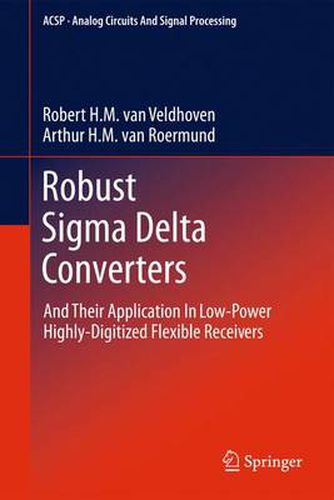Readings Newsletter
Become a Readings Member to make your shopping experience even easier.
Sign in or sign up for free!
You’re not far away from qualifying for FREE standard shipping within Australia
You’ve qualified for FREE standard shipping within Australia
The cart is loading…






This title is printed to order. This book may have been self-published. If so, we cannot guarantee the quality of the content. In the main most books will have gone through the editing process however some may not. We therefore suggest that you be aware of this before ordering this book. If in doubt check either the author or publisher’s details as we are unable to accept any returns unless they are faulty. Please contact us if you have any questions.
Sigma Delta converters are a very popular choice for the A/D converter in multi-standard, mobile and cellular receivers. Key A/D converter specifications are high dynamic range, robustness, scalability, low-power and low EMI. Robust Sigma Delta Converters presents a requirement derivation of a Sigma Delta modulator applied in a receiver for cellular and connectivity, and shows trade-offs between RF and ADC. The book proposes to categorize these requirements in 5 quality indicators which can be used to qualify a system, namely accuracy, robustness, flexibility, efficiency and emission. In the book these quality indicators are used to categorize Sigma Delta converter theory. A few highlights on each of these quality indicators are;
Quality indicators: provide a means to quantify system quality. Accuracy: introduction of new Sigma Delta Modulator architectures. Robustness: a significant extension on clock jitter theory based on phase and error amplitude error models. Extension of the theory describing aliasing in Sigma Delta converters for different types of DACs in the feedback loop.
Flexibility: introduction of a Sigma Delta converter bandwidth scaling theory leading to very flexible Sigma Delta converters.
Efficiency: introduction of new Figure-of-Merits which better reflect performance-power trade-offs.
Emission: analysis of Sigma Delta modulators on emission is not part of the book
The quality indicators also reveal that, to exploit nowadays advanced IC technologies, things should be done as much as possible digital up to a limit where system optimization allows reducing system margins. At the end of the book Sigma Delta converter implementations are shown which are digitized on application-, architecture-, circuit- and layout-level.
Robust Sigma Delta Converters is written under the assumption that the reader has some background in receivers and in A/D conversion.
$9.00 standard shipping within Australia
FREE standard shipping within Australia for orders over $100.00
Express & International shipping calculated at checkout
This title is printed to order. This book may have been self-published. If so, we cannot guarantee the quality of the content. In the main most books will have gone through the editing process however some may not. We therefore suggest that you be aware of this before ordering this book. If in doubt check either the author or publisher’s details as we are unable to accept any returns unless they are faulty. Please contact us if you have any questions.
Sigma Delta converters are a very popular choice for the A/D converter in multi-standard, mobile and cellular receivers. Key A/D converter specifications are high dynamic range, robustness, scalability, low-power and low EMI. Robust Sigma Delta Converters presents a requirement derivation of a Sigma Delta modulator applied in a receiver for cellular and connectivity, and shows trade-offs between RF and ADC. The book proposes to categorize these requirements in 5 quality indicators which can be used to qualify a system, namely accuracy, robustness, flexibility, efficiency and emission. In the book these quality indicators are used to categorize Sigma Delta converter theory. A few highlights on each of these quality indicators are;
Quality indicators: provide a means to quantify system quality. Accuracy: introduction of new Sigma Delta Modulator architectures. Robustness: a significant extension on clock jitter theory based on phase and error amplitude error models. Extension of the theory describing aliasing in Sigma Delta converters for different types of DACs in the feedback loop.
Flexibility: introduction of a Sigma Delta converter bandwidth scaling theory leading to very flexible Sigma Delta converters.
Efficiency: introduction of new Figure-of-Merits which better reflect performance-power trade-offs.
Emission: analysis of Sigma Delta modulators on emission is not part of the book
The quality indicators also reveal that, to exploit nowadays advanced IC technologies, things should be done as much as possible digital up to a limit where system optimization allows reducing system margins. At the end of the book Sigma Delta converter implementations are shown which are digitized on application-, architecture-, circuit- and layout-level.
Robust Sigma Delta Converters is written under the assumption that the reader has some background in receivers and in A/D conversion.